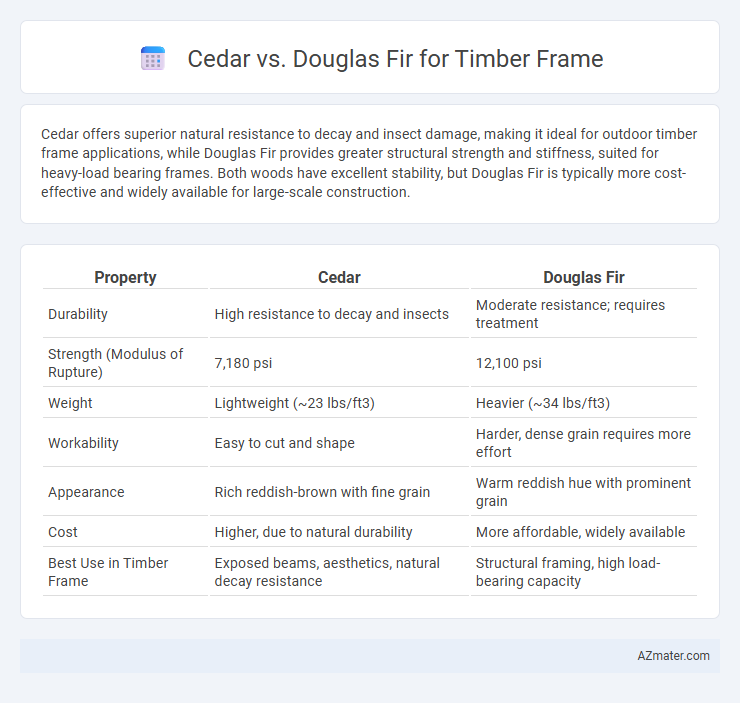Cedar offers superior natural resistance to decay and insect damage, making it ideal for outdoor timber frame applications, while Douglas Fir provides greater structural strength and stiffness, suited for heavy-load bearing frames. Both woods have excellent stability, but Douglas Fir is typically more cost-effective and widely available for large-scale construction.
Table of Comparison
| Property | Cedar | Douglas Fir |
|---|---|---|
| Durability | High resistance to decay and insects | Moderate resistance; requires treatment |
| Strength (Modulus of Rupture) | 7,180 psi | 12,100 psi |
| Weight | Lightweight (~23 lbs/ft3) | Heavier (~34 lbs/ft3) |
| Workability | Easy to cut and shape | Harder, dense grain requires more effort |
| Appearance | Rich reddish-brown with fine grain | Warm reddish hue with prominent grain |
| Cost | Higher, due to natural durability | More affordable, widely available |
| Best Use in Timber Frame | Exposed beams, aesthetics, natural decay resistance | Structural framing, high load-bearing capacity |
Introduction to Cedar and Douglas Fir for Timber Framing
Cedar offers exceptional natural decay resistance and dimensional stability, making it an ideal choice for timber framing in moist or outdoor environments. Douglas Fir is prized for its superior strength-to-weight ratio and straight grain, providing excellent load-bearing capacity in structural applications. Both woods combine durability and aesthetic appeal, but Douglas Fir typically delivers greater structural performance while Cedar excels in longevity and resistance to insects.
Timber Strength: Cedar vs Douglas Fir
Douglas Fir exhibits superior timber strength compared to Cedar, making it a preferred choice for structural applications requiring high load-bearing capacity. Its higher density and stiffness contribute to greater bending strength and shear resistance, essential for durable timber frame construction. Cedar, while valued for its natural resistance to decay and aesthetic appeal, has lower compressive strength and is best suited for non-structural or ornamental uses in timber framing.
Durability and Longevity Comparison
Cedar offers exceptional natural resistance to decay, insects, and moisture, making it highly durable for timber frame construction in various climates. Douglas Fir is renowned for its superior strength and dimensional stability, but it requires proper treatment to enhance its resistance to rot and insect damage. Both woods provide long-lasting performance, with cedar excelling in longevity due to its natural oils and Douglas Fir delivering structural reliability when maintained correctly.
Resistance to Decay and Insects
Cedar offers superior resistance to decay and insect infestation due to naturally occurring oils and extractives, making it ideal for durable timber frames in moist environments. Douglas fir, while strong and structurally stable, requires additional treatment to enhance its resistance against rot and pests. Selecting cedar ensures longer-lasting timber frames with minimal maintenance in decay-prone conditions.
Workability and Ease of Use
Douglas Fir offers superior workability for timber frames due to its consistent grain and moderate hardness, allowing for precise cuts and minimal splitting during machining. Cedar is valued for its lightweight and natural resistance to decay, but its softer wood can be prone to denting and may require more careful handling to avoid damage. Both species are easy to use, but Douglas Fir's strength combined with smooth machining makes it a preferred choice for complex joinery and structural elements.
Aesthetic Appeal and Grain Patterns
Cedar timber frames boast a rich reddish hue with tight, straight grain patterns, offering a warm and rustic aesthetic that ages gracefully to a silvery gray. Douglas Fir presents a lighter, golden color with bold, pronounced grain lines and occasional knots, delivering a striking, sturdy visual appeal. Both species provide distinct textures and tones, with cedar favored for its smooth finish and Douglas Fir for its dramatic grain contrast in timber framing.
Cost and Availability Considerations
Douglas Fir is generally more affordable and widely available than Cedar, making it a cost-effective choice for timber frame construction. Cedar offers natural resistance to decay and insects but comes at a higher price point due to its premium quality and limited supply. Builders often select Douglas Fir when budget constraints and material accessibility are critical, whereas Cedar is chosen for its aesthetic appeal and durability despite higher costs.
Environmental Impact and Sustainability
Cedar and Douglas Fir both offer sustainable options for timber frames, with cedar naturally resistant to decay, reducing the need for chemical treatments and extending the lifespan of structures. Douglas Fir is highly valued for its strength-to-weight ratio and fast growth rates, making it a renewable resource when harvested from responsibly managed forests. Life cycle assessments indicate cedar typically has a lower carbon footprint due to its durability, while Douglas Fir's efficiency in construction helps reduce overall material use and energy consumption.
Best Applications for Cedar and Douglas Fir
Cedar offers exceptional natural resistance to decay and insect damage, making it ideal for outdoor timber frame applications such as pergolas, decks, and siding where durability and weather resistance are critical. Douglas Fir provides superior structural strength and stiffness, making it the preferred choice for heavy-duty framing, beams, and load-bearing elements in large timber frame constructions. Both woods excel in aesthetic appeal, with cedar's rich color and aromatic qualities suited for visible finishes, while Douglas Fir's straight grain supports precision joinery in complex framing systems.
Conclusion: Choosing the Right Timber for Your Frame
Cedar offers superior natural resistance to decay and insect damage, making it ideal for long-lasting timber frames in outdoor or humid environments. Douglas fir provides exceptional strength and stiffness, suitable for structural applications requiring high load-bearing capacity. Selecting the right timber depends on balancing durability needs with structural performance for your specific framing project.

Infographic: Cedar vs Douglas Fir for Timber Frame
 azmater.com
azmater.com